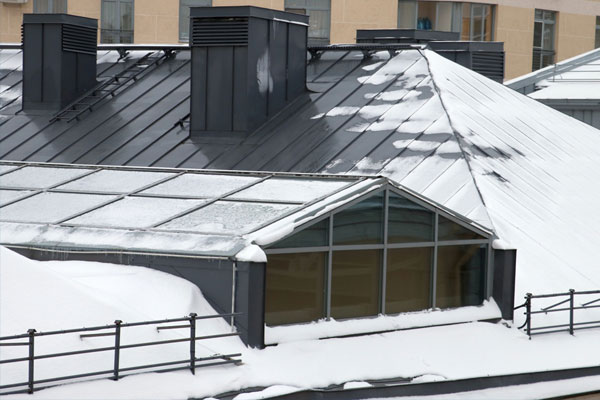Metal Roofing in Winter: Design Tips for Cold Weather Climates
Author: Michael Russo | February 13, 2023
Metal roofing systems have a good performance record in harsh winter environments, as long as they are correctly designed. Key factors typically include adequate slope and proper structural design. Installing a quality vapor retarder and/or roof underlayment may also be critical, depending on the specification.

If these issues are addressed during the design stage, a metal roof in winter will almost always perform as intended. However, there may be times when a roofing contractor is brought onto a project after the design has been finalized or hired to make repairs on an existing metal roof that wasn't designed to hold up to harsh weather. Fortunately, there are several ways a problematic roof can be retrofitted to stand up to snow and ice.
How Much Slope Is Enough?
A few standing seam metal roofing suppliers may still approve a minimum quarter-inch-per-foot slope as a testament to the waterproofing integrity of their systems. But even in relatively mild climates, this type of low-slope specification is risky at best, even when using an exceptional roof underlayment. Nearly flat roofs may leak and collapse in the face of intense snowfall.
So, how can a roofing contractor add slope to a leaking metal roof?
One solution that has worked for many roofing professionals is a retrofit framing system. These metal-over-metal systems add a new metal roof above the existing one without disrupting tenants or building operations.
Retrofit framing systems may also offer other benefits, such as:
● Enhanced wind-loading.
● Decreased purlin spacing.
● Additional insulation for greater energy efficiency.
Another option involves installing a single-ply membrane roof such as thermoplastic polyolefin (TPO) over an insulation system (formed by polyisocyanurate insulation) over the top and expanded polystyrene (EPS) insulation between the flutes.
Solving Condensation Problems
Where there is a significant presence of moisture (more than 30% relative humidity) inside a building in a cold or even cool climate, condensation can occur beneath a metal roof. The use of a simple vapor retarder such as a fiberglass (insulation) facer can limit this phenomenon, but the seams cannot be overlapped or rolled and stapled.
All types of vapor retarders must be sealed and airtight in their entirety. To achieve that, seams and penetrations must be sealed where the floor and wall meet and at the intersections of the roof and walls.
Because getting an airtight seal can be difficult, foam insulated panels are a good choice in cold climates for buildings with high interior humidity, such as pools, printing facilities and trash plants.
There are also pressure-sensitive tapes available that can seal the seams on a vapor retarder; however, the tape will not bond to damp or dusty surfaces. Additionally, the tape must be pressed into place for a long-lasting seal. When properly installed, a quality tape can last the life of the building, according to Construction Magazine.
Snow Loading on a Metal Roof in Winter
The cumulative snowfall in Northern New England can be as much as 8 feet annually. However, there does not need to be 8 feet of snow on a metal roof to cause problems. Lesser amounts have kept consulting engineers busy and building owners holding their heads.
On a standing seam roof with side valleys, uneven ice formation can rip off gutters and tear through even 29-gauge steel. One solution is to install snow blocking devices on both sides of the valley to prevent any ice "glaciers" that form from damaging the standing seams.
Metal roofing systems can also rapidly shed accumulated snow as the weather warms, which can pose a safety hazard for anyone on the ground below. Installing snow brakes or ice guards can help prevent heavy snow from dropping off and causing injury or damage.
In these cases, when a roof springs a leak or has other significant maintenance needs, the roofing contractor is often the first person to be blamed, even if they installed a system that someone else designed. Doing careful research and suggesting proven retrofitting solutions—and seeking out a specialized, professional designer if necessary—can help to keep your reputation and your customers' roofs secure all winter long.